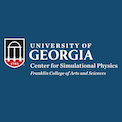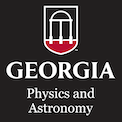Events Calendar View
-
Departmental Colloquium
Mar 3, 2016
Probing the Beginnings of Planetary Birth in the Age of ALMA
The Atacama Large Millimeter Array (ALMA) has begun operations in the high desert of northern Chile offering unprecedented spatial resolution and sensitivity within the millimeter and sub-millimeter atmospheric windows. The study of planet birth is one of the key science areas enabled by ALMA due to the ability to resolve both gas and dust emission within the planet formation zones of young gas-rich circumstellar disks. This is highlighted by the fantastic high resolution image of HL Tau showing significant structure in the emission from pebbles within a young disk that is still accreting from its natal envelope. In this talk I will explore the related physics and chemistry of gas-rich disks and emphasize new breakthroughs in our understanding brought about by ALMA in concert with data from the Herschel Space Observatory. In particular I will report on the physical/chemical links in terms of snow-lines and the likely formation of pebbles and possibly planetesimals. Snow-lines represent chemical transitions (ice to vapor) in the disk and have long been posited as favorable sites for planet formation. With ALMA we have now directly and indirectly resolved the carbon monoxide snow-line in several disk systems. I will present these data and show compelling new evidence that grain growth is fostered at these locations, perhaps giving rise to the fantastic structure seen in HL Tau. Furthermore the formation of ice-coated pebbles in the increasingly dust rich midplane must deplete the upper layers, and due to radial drift, the outer disk of key ices that carry C, H, O, N. We will show that there is strong evidence for missing volatiles in the disk surfaces layers of the nearest disk system (TW Hya) with an apparent radial gradient in the carbon to oxygen content in the gas and solids. This elemental abundance gradient will likely be imprinted within the atmospheres of forming gas giants and sets constraints on the location of the volatile reservoir needed to form habitable terrestrial worlds. -
Departmental Colloquium
Mar 17, 2016
The Baryon Spectroscopy Program at JLAB
The strong interaction still provides mysteries to us, like the generation of mass and the fact that the most elementary particles --quarks and gluons-- cannot be directly observed. Measuring so-called baryonic resonances to shed light on these 40-years old problems, is a large-scale experimental effort at the Jefferson National Accelerator Facility (JLab). An overview of present and future JLab activities will be given, focused on the question of how to connect observations to theory. In particular, first results and their analysis from the Frozen Spin Target (FroST) Lab will be discussed.
Conclusive answers in baryon spectroscopy are a long-sought goal. Necessary steps towards this goal will be discussed, such as statistical criteria, the need for hadron beams, and the need for a suitable amplitude parameterization to make the connection to (ab-initio) lattice QCD approaches. The material will be presented for a broader audience.
-
CSP Lunch Seminar
Mar 22, 2016
Conformational behavior of Polyampholyte Brushes and electrokinetic transport dynamics in nano channels: molecular dynamics method

Guest: Hao You, Center for Simulational Physics, University of Georgia
Tuesday, March 22, 2016 12:30 pm - 1:30 pm
Location: CSP Conference Room (Room 322)Polyampholyte are water-soluble polymers containing both cationic and anionic groups. They are ubiquitous in nature such as genetic material (DNA and RNA) and proteins and thus are of fundamental scientific interest and have a wide range of industrial applications. In this talk we present some of our recent work: 1) conformational behaviors of the polyampholytes coated onto the internal surface of a spherical cavity. 2) The valency of the counterion effects.
The implementation of the nanochannel functionalities mainly depends on the physico-chemical properties of the surfaces, which have critical effects on the transport behavior of the confined fluid and the structure of the solvent in the interfacial region. A strategy to modify the surface properties is to graft polymers brushes onto the surfaces of the solid-state channels.We simulate electrokinetic transport dynamics in mixed polymer brush-grafted nanochannels, where two distinct species of polymers are alternately grafted on the inner surface of nano channels.
-
Departmental Colloquium
Mar 24, 2016
Revisiting Decades-Old Physics to Improve Modern Molecular Imaging
Molecular imaging-the use of chemical signatures to image function instead of merely structure-promises to enable a new generation of clinical modalities that can revolutionize both diagnosis and treatment. I will focus on two specific modalities-magnetic resonance and optical imaging-and discuss how a close coupling between basic physics on the one hand, and focused clinical questions on the other hand, enable new and important applications. In magnetic resonance, one of the most startling results of the last few decades was our work that showed coherences survive at room temperature between pairs of nuclear spins separated by many microns or millimeters. This gives insight into fundamental questions in quantum mechanics, such as the differences between coherence, correlation and entanglement; it also lets us image temperature in vivo, measure local anisotropy, and detect tissue activation. We have used fundamental symmetries in spin physics to populate states which are immune to most relaxation mechanisms (and thus persist for minutes to hours). Coupled with a new catalytic approach to enhance molecular magnetization by about a factor of 100,000 over thermal values, this can improve the molecular information in clinical imaging. In optics, our lab developed femtosecond pulse shaping technologies two decades ago. Today we know that the "killer application" is to access intrinsic nonlinear signatures at exceedingly low powers (less average power than a laser pointer). This makes it possible to gain image contrast from effects that were not previously observable in soft matter, such as excited state absorption, ground state depletion, and cross phase modulation. Applications to imaging hemoglobins and melanins in tissue to detect and assess cancer will be highlighted; I will also present work on nonlinear imaging of historical pigments in Renaissance paintings to infer the artist’s original colors and intent. -
Observatory Open House
Mar 25, 2016
Special Observatory Viewing
The 24 inch telescope has been fixed!
Our first public viewing with the newly fixed telescope will be a special viewing on March 25, 2016. Because of the limited space in the dome, you must have a reservation to come to this showing. Click here to make a reservation.
The observatory is located at the top of the Physics building. To get to the observatory take the elevator to the 4th floor. A guide will meet you on the 4th floor and direct your group to the stairway that leads to the observatory. As the weather can be unpredictable, we might not know whether a viewing will be possible until shortly before the event begins.
If you need more information please call 706-542-2485.
-
CSP Lunch Seminar
Mar 29, 2016
Fenton reactions and Cancer
Page 64 of 121, showing 6 records out of 723 total, starting on record 379, ending on 384


